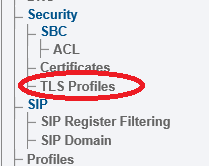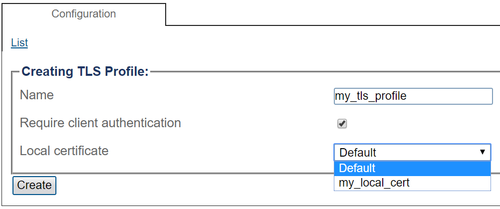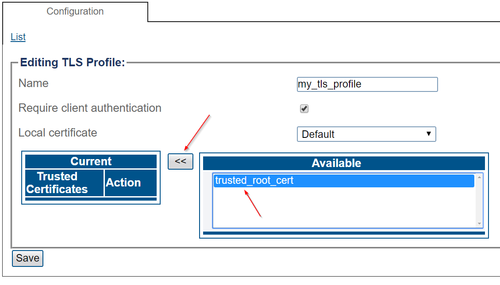Toolpack:Tsbc TLS Profiles
From TBwiki
(Difference between revisions)
| (14 intermediate revisions by 3 users not shown) | |||
| Line 1: | Line 1: | ||
| − | + | {{DISPLAYTITLE:Configuring TLS Profiles}} | |
| − | {{DISPLAYTITLE:Configuring | + | |
| − | ''''' | + | {| class="wikitable" |
| + | |- | ||
| + | |rowspan="2"|This article applies to: | ||
| + | |'''Product''' | ||
| + | |'''Version''' | ||
| + | |- | ||
| + | |SBC | ||
| + | |3.1 | ||
| + | |} | ||
| − | Multiple TLS profiles can be created in [[Toolpack]]. A TLS profile is a collection of certificates and other settings that define the behavior of TLS connections. Multiple TLS profiles can be used to expose different certificates and options to different TLS connections in [[Toolpack]], | + | Multiple TLS profiles can be created in [[Toolpack]]. A TLS profile is a collection of certificates and other settings that define the behavior of TLS connections. Multiple TLS profiles can be used to expose different certificates and options to different TLS connections in [[Toolpack]], athough one TLS profile is generally enough. |
| − | == | + | == Create TLS profile == |
| − | + | 1. Select '''TLS Profiles''' from the navigation panel | |
| − | [[Image: | + | [[Image:ConfigureTlsProfile_0.png]] |
| − | + | 2. Click ''' Create New TLS Profile''' | |
| − | [[Image: | + | [[Image:ConfigureTlsProfile_1.png]] |
| − | + | 3. Configure TLS Profile parameters | |
| − | * | + | * Provide a name that is meaningful to you. |
| − | * | + | * Check if client authentication is required. Enabling this checkbox means that incoming connections require the remote side to present a or many trusted certificate(s) (later selected after creation). |
| − | * | + | * Select a local certificate (either one imported earlier, or the "Default" certificate which is automatically generated by Toolpack and is also used for HTTPS) |
* Click "Create" | * Click "Create" | ||
| − | [[Image: | + | [[Image:ConfigureTlsProfile_2.png|500px]] |
| − | + | * Select one or multiple "trusted" certificates, only necessary if "Require peer authentication" is checked. | |
| − | + | ||
| − | [[Image: | + | [[Image:ConfigureTlsProfile_3.png|500px]] |
| − | |||
| − | |||
| − | |||
| − | |||
| − | |||
| − | |||
| − | |||
| − | |||
| − | |||
| − | |||
| − | |||
| − | |||
| − | |||
| − | |||
| − | |||
| − | |||
| − | |||
| − | |||
| − | |||
| − | |||
| − | |||
| − | |||
| − | |||
| − | |||
| − | |||
| − | + | == List of Parameters == | |
| − | [[ | + | *[[Parameter: Name|Name]] |
| + | *[[Parameter: Require client authentication|Require client authentication]] | ||
| + | *[[Parameter: Local certificate|Local certificate]] | ||
Latest revision as of 09:02, 15 December 2020
| This article applies to: | Product | Version |
| SBC | 3.1 |
Multiple TLS profiles can be created in Toolpack. A TLS profile is a collection of certificates and other settings that define the behavior of TLS connections. Multiple TLS profiles can be used to expose different certificates and options to different TLS connections in Toolpack, athough one TLS profile is generally enough.
Create TLS profile
1. Select TLS Profiles from the navigation panel
2. Click Create New TLS Profile
3. Configure TLS Profile parameters
- Provide a name that is meaningful to you.
- Check if client authentication is required. Enabling this checkbox means that incoming connections require the remote side to present a or many trusted certificate(s) (later selected after creation).
- Select a local certificate (either one imported earlier, or the "Default" certificate which is automatically generated by Toolpack and is also used for HTTPS)
- Click "Create"
- Select one or multiple "trusted" certificates, only necessary if "Require peer authentication" is checked.



